
Once upon a time the Yankees had a middling — if not miserable — farm system that failed year after year to supplement the big league roster with cheap and productive talent. Aside from a Brett Gardner here and a David Robertson there, the farm system produced very little from Robinson Cano’s debut through about the middle of the 2015 season.
That has changed. Now? Now the Yankees produce stars. Within the last two and a half years the farm system produced the 2016 AL Rookie of the Year runner-up, the unanimous 2017 AL Rookie of the Year and 2017 AL MVP runner-up, and the third place finisher in the 2017 AL Cy Young voting. Gary Sanchez, Aaron Judge, and Luis Severino are just the start too. Don’t forget Greg Bird, Jordan Montgomery, or Chad Green. Or all the highly regarded prospects the Yankees cashed in as trade chips.
Suddenly the Yankees are a player development machine. They graduated all that talent, traded all those prospects, and still have a deep farm system. Both Keith Law and Baseball America rank the system as the second best in baseball going into the new season. The Yankees have star power and depth in the farm system. Position players and pitchers. Everything you could want. Well, except catchers. The Yankees are a little short on catching prospects at the moment, but when you have Sanchez at the big league level, that’s not a huge deal.
This is my 12th year — 12th year! — ranking Yankees prospects at RAB, and I’m pretty sure I’ve never considered as many prospects for my annual top 30 prospects list as this year. Some years it was a struggle to get to 30 names. Some years you have a few extra names to consider. This year the list of prospects I seriously considered for the top 30 included 48 names. Guys like Cody Carroll, Ben Heller, and Nick Nelson would’ve been easy top 30 prospects two or three years ago. This year they didn’t make the top 40.
That is my long way of saying the Yankees are loaded with prospects right now. I know we’ve been hearing the system is deep for however many months now, but it is shockingly deep. To see all the names on a list in one place is pretty amazing. The Yankees are drafting well, they’re getting quality players in trades, and they’ve knocked it out of park internationally the last few summers.
As a reminder, I am no expert. I am just a guy with a blog who reads a lot and has opinions about prospects. I’m wrong about players all the time. All the time. Disagree with my rankings? That’s cool. Mock me as you please. There is no correct way to rank prospects. It’s all about balancing upside with probability, and tools with performance. Finding the right balance is tough, and once you think you’ve got it, some prospect changes your mind.
Anyway, all of my top 30 lists are right here. I use the MLB rookie limits of 130 at-bats and 50 innings to determine prospect eligibility. I don’t worry about service time. That stuff is too much of a headache to track. All headshots come from MLB.com or MiLB.com unless noted otherwise. This year’s top 30 prospects are after the jump. Enjoy.
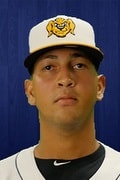 No. 30: ALEX VARGAS, rhsp
No. 30: ALEX VARGAS, rhsp
DOB: July 24th, 1997 (age 20)
Height, Weight, Bats/Throws: 6-foot-4, 203 lbs., right/right
Acquired: Signed July 2014 out of the Dominican Republic ($10,000 bonus)
2017 Stats: 2.74 ERA (3.74 FIP), 17.1 K%, 2.9 BB% (72.1 IP at SS/A-)
Projected 2018 Level: Low-A and maybe High-A
The Good: Back trouble prevented Vargas from taking the mound in an official game in 2016, and when he returned in 2017, his lively three-pitch mix and strike-throwing ability had not been compromised. Vargas works in the low-90s with a bowling ball sinker and backs it up with a firm low-80s changeup that tumbles down and out of the strike zone. He also throws a curveball that is currently his clear third pitch, but shows potential. Vargas has a clean and efficient delivery and throws lots of strikes. Lots and lots of strikes.
The Bad: The history of back problems, first and foremost. Back trouble never really goes away. It’s something that has to be managed forever. It also cost him development time in 2016. Beyond that, Vargas doesn’t have a swing-and-miss pitch at the moment, so when he’s in the jam, he’ll chunk a sinker down the middle and hope for a grounder at an infielder. The hope is the curveball will improve to the point where Vargas can use it to get strikeouts and escape jams without a ball being put in play.
The Immediate Future: Vargas made nine starts with Low-A Charleston last season and sending him back there to start this season is the obvious move. If he stays healthy and has success, a move up to High-A Tampa at some point is possible. Vargas will be Rule 5 Draft eligible after the season and he has good enough stuff to sneak onto the 40-man roster, as long as the back holds up.
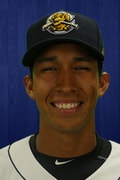 No. 29: OSWALDO CABRERA, ss
No. 29: OSWALDO CABRERA, ss
DOB: March 1st, 1999 (age 18)
Height, Weight, Bats/Throws: 5-foot-10, 145 lbs., switch/right
Acquired: Signed July 2015 out of Venezuela ($100,000 bonus)
2017 Stats: .252/.306/.321 (85 wRC+), 4 HR, 6.7 BB%, 12.6 K% (451 PA at SS/A-)
Projected 2018 Level: Low-A
The Good: Cabrera has never not received praise for his natural ability and work ethic. He’s a switch-hitter who has a Greg Bird-esque calm at the plate and works at-bats like a veteran. He makes consistent contact and slashes the ball to all fields from both sides of the plate. Cabrera’s best tools defensively are his soft hands and instincts. The Yankees have had him play the three non-first base infield positions in his career and he’s handled each with aplomb. Cabrera doesn’t play like teenager. He carries himself like a veteran and knows the game.
The Bad: There is no standout tool here. Cabrera doesn’t have much power at all, from either side of the plate, and he’s not a burner. His range in the field is somewhat limited and his arm isn’t great, so his chances of sticking at short aren’t particularly good, and third base probably isn’t a long-term fit either. Cabrera’s instincts have helped him overcome his defensive shortcomings up to this point.
The Immediate Future: The Yankees did Cabrera no favors by starting him with Low-A Charleston last season. He hit .242/.298/.314 (75 wRC+) in 89 games with the RiverDogs before being down to Short Season Staten Island, the more age-appropriate level, at midseason. A return trip to Charleston is in the cards this season, and Cabrera figures to spend the entire year there.
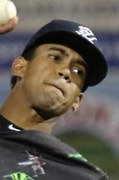 No. 28: DEIVI GARCIA, rhsp
No. 28: DEIVI GARCIA, rhsp
DOB: May 9th, 1999 (age 18)
Height, Weight, Bats/Throws: 5-foot-10, 163 lbs., right/right
Acquired: Signed July 2015 out of the Dominican Republic ($200,000 bonus)
2017 Stats: 4.03 ERA (3.81 FIP), 37.6 K%, 9.6 BB% (44.2 IP at Rk)
Projected 2018 Level: Extended Spring Training and rookie ball
The Good: Garcia is one of the many quality pitching prospects the Yankees have signed to a low six-figure bonus in recent years. His fastball hums in at 91-94 mph and he’ll touch 96 mph regularly, and he gets to that velocity pretty effortlessly too. Deivi’s curveball is the separator. It’s a power curve with snappy downward action and an elite spin rate. (Josh Norris said Garcia’s curveball has measured at 3,000 rpm, which is a top of the scale spin rate even for big leaguers.) Rookie ball hitters had no chance against his curve last year. A work in progress changeup rounds out Garcia’s repertoire. Because he’s athletic and his delivery is fairly smooth, the expectation is Deivi will add velocity and improve his command as he matures physically.
The Bad: Two things. One, Garcia has presently below-average control and non-existent command that will have to improve for him to go anywhere. And two, his size. Garcia is a bit bigger than his listed height and weight, but not much bigger. He’s a sub-6-foot-0 right-hander, and that brings inevitable questions about his durability and ability to pitch downhill.
The Immediate Future: Garcia is a clear Extended Spring Training to short season league candidate going into 2018 given his age and lack of control. Not an uncommon path for an 18-year-old kid at all. (Photo via Pinstriped Prospects)
 No. 27: DIEGO CASTILLO, ss
No. 27: DIEGO CASTILLO, ss
DOB: October 28th, 1997 (age 20)
Height, Weight, Bats/Throws: 6-foot-0, 170 lbs., right/right
Acquired: Signed July 2014 out of Venezuela ($750,000 bonus)
2017 Stats: .263/.310/.315 (83 wRC+), 1 HR, 6.1 BB%, 10.0 K% (510 PA at A-)
Projected 2018 Level: High-A
The Good: Most of the big bonus prospects the Yankees signed during the 2014-15 international signing spree have been left in the dust by smaller bonus players who have performed better, and better harnessed their tools. Castillo is one of those smaller bonus players. He’s a true shortstop with range, good hands, and a strong arm. He is a natural at the position and makes things look easy. On offense, Castillo is a bat control hitter who inside-outs almost everything to right field. He grew up idolizing Derek Jeter and he has a similar approach at the plate. Castillo looks to go the other way with every pitch. He makes plenty of contact — a 10.0% strikeout rate as a 19-year-old in full season ball is pretty impressive — and runs well, so he adds value on the bases too.
The Bad: Castillo’s offensive ceiling isn’t high at all. He has minimal power — even when he gets a mistake and pulls it to left field, he doesn’t have the strength to clear the wall more than a few times a year — and profiles as a singles hitter who finds a few gaps for doubles. Castillo also doesn’t walk much, so most of his offensive value is tied up in his batting average.
The Immediate Future: I could see the Yankees starting Castillo back with Low-A Charleston this year, though he’s probably ready for High-A Tampa, even with last year’s underwhelming numbers. Castillo, like everyone else from the 2014-15 international class, will be Rule 5 Draft eligible next offseason.
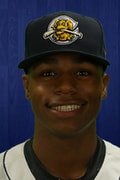 No. 26: ISIAH GILLIAM, of
No. 26: ISIAH GILLIAM, of
DOB: July 23rd, 1996 (age 21)
Height, Weight, Bats/Throws: 6-foot-3, 220 lbs., switch/right
Acquired: 2015 20th round, 603rd overall ($550,000 bonus)
2017 Stats: .275/.356/.468 (137 wRC+), 15 HR, 10.8 BB%, 21.7 K% (511 PA at A-)
Projected 2018 Level: High-A and possibly Double-A
The Good: The Yankees liked Gilliam’s power potential so much that they gave him the largest bonus they’ve given any player after the tenth round since the bonus pool system was implemented in 2012. ($450,000 of his $550,000 bonus counted against the pool.) Less than three years later, it looks like a wise investment, as some mechanical changes — specifically, the Yankees lowered his hands and widened his base — have helped Gilliam tap into his raw power from both sides of the plate. There is some swing-and-miss in his game and probably always will be, but Gilliam knows the difference between a ball and a strike, and he generates above-average bat speed from both sides. He’ll punish mistakes. After spending much of his amateur career at first base, the Yankees moved Gilliam to the outfield full-time as a pro and he’s handled it well.
The Bad: Gilliam is a switch-hitter but he has been much more productive as a right-handed hitter thus far in his career: .316/.355/.562 against lefties and .242/.336/.391 against righties. His strong side is the light side of the platoon, which isn’t ideal. Also, Gilliam isn’t much of a runner and his outfield defense can best be described as adequate, though I suppose inexperience could be a factor there. Still, being a switch-hitter with power and a plan from both sides of the plate makes for a good prospect.
The Immediate Future: Gilliam spent all of last season with Low-A Charleston and was one of the better hitters in the league, so a bump up to High-A Tampa is the next logical step. I wouldn’t rule out a late season promotion to Double-A Trenton.
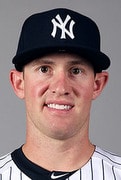 No. 25: BILLY McKINNEY, of
No. 25: BILLY McKINNEY, of
DOB: August 23rd, 1994 (age 23)
Height, Weight, Bats/Throws: 6-foot-1, 205 lbs., left/left
Acquired: Aroldis Chapman trade with Cubs (July 25th, 2016)
2017 Stats: .277/.338/.483 (124 wRC+), 16 HR, 7.8 BB%, 18.8 K% (500 PA at AA/AAA)
Projected 2018 Level: Triple-A and MLB
The Good: The Yankees landed McKinney as a secondary piece in the Chapman trade hoping he would rebuild value following a down 2016, and he did exactly that in 2017. McKinney has always had a pretty left-handed swing geared for hard contact, and last season he drove the ball in the air more often than at any other point in his career, hence the career high 16 homers. (His previous career high was eleven in 2014.) McKinney hangs in against lefties and can punish mistakes from righties. He is a corner outfielder by trade, and the Yankees had him work out at first base during the Arizona Fall League in an effort to increase his versatility. They’re looking for ways to get him in the lineup.
The Bad: Even with the big 2017 season, there are still questions about McKinney’s long-term power potential and offensive ceiling. He is not a particularly graceful defender — McKinney played mostly right field last season, but is better suited for left given his below-average arm — so his value is going to be tied tightly to his bat. Even if he works himself into an average defender in a corner outfield spot and/or first base, McKinney might not have enough bat to be more than a complementary player.
The Immediate Future: The Yankees are loaded with outfielders and both Greg Bird and Tyler Austin are ahead of McKinney on the first base depth chart, so a return trip to Triple-A Scranton to begin the season is the logical outcome. He’ll bide his time with the RailRiders until an injury creates a need at the big league level, or until the Yankees cash him in as a trade chip.
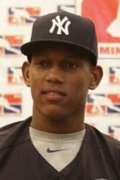 No. 24: ROANSY CONTRERAS, rhsp
No. 24: ROANSY CONTRERAS, rhsp
DOB: November 7th, 1999 (age 18)
Height, Weight, Bats/Throws: 6-foot-0, 175 lbs., right/right
Acquired: Signed July 2016 out of the Dominican Republic ($250,000 bonus)
2017 Stats: 4.26 ERA (4.59 FIP), 11.7 K%, 8.3 BB% (31.2 IP at Rk)
Projected 2018 Level: Extended Spring Training and rookie ball
The Good: The Yankees were limited to $300,000 bonuses during the 2016-17 international signing period because they were still in the penalty phase for the 2014-15 spending spree, yet they still managed to land Contreras, the top ranked Dominican pitcher that summer. Contreras has an advanced three-pitch mix starting with an easy low-90s fastball. He has a very quick arm and the ball jumps out of his hand, so it’s easy to project mid-90s gas once he fills out. His overhand curveball has big break and a high spin rate. Contreras also has a sneaky good changeup he doesn’t throw often enough. As much as the raw stuff, Contreras stands out for his mound presence and his maturity. He carries himself like a veteran and doesn’t get rattled when things go wrong.
The Bad: Needless to say, there’s a ton of risk here because we’re talking about a just turned 18-year-old kid with ten minutes of rookie ball experience. Contreras has to gain consistency with his stuff, especially his changeup, and also refine his mechanics and do a better job repeating his delivery. His control will come and go, and that’s tied to the whole “do a better job repeating his delivery” thing. None of this is uncommon for a kid this age. Contreras has to work on typical 18-year-old pitcher stuff.
The Immediate Future: Given his age, chances are Contreras will be held back in Extended Spring Training to start the season before joining one of the short season leagues in June. Pulaski seems more likely than Staten Island only because it’s more age appropriate. The Yankees might not want to throw Contreras out there against college kids just yet. (Photo via @RoansyContreras)
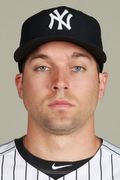 No. 23: JAKE CAVE, of
No. 23: JAKE CAVE, of
DOB: December 4th, 1992 (age 25)
Height, Weight, Bats/Throws: 6-foot-0, 200 lbs., left/left
Acquired: 2011 sixth round, 209th overall ($800,000 bonus)
2017 Stats: .305/.351/.542 (145 wRC+), 20 HR, 26.3 K%, 6.4 BB% (437 PA at AA/AAA)
Projected 2018 Level: Triple-A and MLB
The Good: Cave’s story is one of perseverance. Last season was his third straight season splitting time between Double-A and Triple-A, and after the Reds returned him as a Rule 5 Draft pick at the end of Spring Training 2016, Cave earned his way back onto the 40-man roster in 2017. He did that by making some swing changes designed to get the ball airborne and generate more power, and it worked like a charm. Cave shattered his previous career high in home runs (eight in 2016), and he also shattered his previous career high strikeout rate (22.6% in 2016). His old slash-and-dash approach wasn’t getting him very far, so he started selling out for power, and bam, he’s back on the 40-man. Cave is also a good runner capable of manning all three outfield spots, giving him a nice little well-rounded game.
The Bad: At this point Cave is strictly a platoon bat — he hit .217/.271/.367 with a 28.7% strikeout rate against lefties last year — and his days in center field may be numbered due to knee issues. He missed the entire 2012 season with a broken right kneecap (it didn’t heal properly initially), and he missed the start of last season after having arthroscopic surgery on his left knee. Even with his new approach, Cave could very well end up a ‘tweener, someone without enough defense for center or enough bat for a corner. It’s a fourth outfielder profile more than anything and hey, there’s nothing wrong with that. Big league fourth outfielder still means big leaguer.
The Immediate Future: Cave will have to return to Triple-A because the Yankees are so deep in outfielders. He might not even be the first guy called up when an outfielder is needed. There’s a decent chance Cave will be playing for a spot with another team this season. The Yankees might not be able to keep him around long given their outfield depth and the potential need for a 40-man spot, so Cave could be trade bait. (Photo via Presswire)
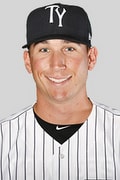 No. 22: TAYLOR WIDENER, rhsp
No. 22: TAYLOR WIDENER, rhsp
DOB: October 24th, 1994 (age 23)
Height, Weight, Bats/Throws: 6-foot-0, 195 lbs., left/right
Acquired: 2016 12th round, 368th overall ($100,000 bonus)
2017 Stats: 3.39 ERA (3.05 FIP), 26.4 K%, 10.2 BB% (119.1 IP at A+)
Projected 2018 Level: Double-A and possibly Triple-A
The Good: The Yankees put their best arms in the rotation in the minors, even the relievers, and that’s what they did with Widener last year. His first full year as a starter went well and he held his stuff throughout. Widener operates with a 93-95 mph fastball as a starter, and he can reach back for 97 mph in big spots. A mid-80s slider is his primary secondary offering, and while he’s still working to harness it completely, the pitch can be a devastating swing-and-miss offering against both righties and lefties on its best days. Widener hasn’t had much problems throwing strikes. Last year’s high walk rate stems mostly from a midseason slump, when he hit a wall and walked 20 batters in 35.2 innings before getting a second wind.
The Bad: Widener doesn’t have much of a changeup and is working diligently to add one, which he’ll need to do to remain a starter. He also missed time with several injuries in college (knee, back, elbow), so between that and his slight frame, Widener simply might not be up for a starter’s workload even if he can add a changeup.
The Immediate Future: Widener’s first season as a starter went well and the Yankees will send him to Double-A Trenton as a starter this year. There’s no shortage of arms at the upper levels, so they can be patient with him to see how the changeup comes long, and how he handles an increased workload.
 No. 21: TREVOR STEPHAN, rhsp
No. 21: TREVOR STEPHAN, rhsp
DOB: November 25th, 1995 (age 22)
Height, Weight, Bats/Throws: 6-foot-4, 210 lbs., right/right
Acquired: 2017 third round, 92nd overall ($797,500 bonus)
2017 Stats: 1.31 ERA (1.74 FIP), 34.1 K%, 4.7 BB% (34.1 IP at Rk/SS)
Projected 2018 Level: High-A and Double-A
The Good: There’s not a whole lot to say about Stephan. He’s a pure power pitcher who gets ahead of hitters with a 91-95 mph running two-seam fastball that has gone as high as 98 mph, and puts them away with a short low-80s slider that almost looks like a cutter. Stephan hides the ball well during his delivery and has an aggressive bulldog mentality. He’s a no nonsense guy who goes right after hitters.
The Bad: Two things, really. One, Stephan is still working to develop a reliable changeup. He has a changeup and he throws is surprisingly often, but it’s not a quality or consistent offering. And two, Stephan’s delivery is not pretty at all. He has a short arm action and a crossfire delivery, which would normally suggest he has trouble throwing strikes, but that’s not the case here. Still, between the lack of a changeup and the less-than-stellar delivery, there is plenty of thought Stephan will wind up in a bullpen role long-term.
The Immediate Future: The Yankees stick all their best arms in the rotation in the minors, even when they project out to relievers, so Stephan will continue to start this season. There is a chance the numbers crunch pushes him down to Low-A Charleston come Opening Day, though I think he’ll start in High-A Tampa, and he could get a quick promotion to Double-A Trenton if he overwhelms Single-A hitters. Stephan’s stuff and deception are so good that he might not be challenged much until he gets to Double-A. (Photo via @MLBPipeline)
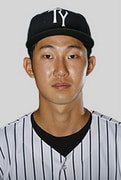 No. 20: HOY JUN PARK, ss
No. 20: HOY JUN PARK, ss
DOB: April 7th, 1996 (age 21)
Height, Weight, Bats/Throws: 6-foot-1, 175 lbs., left/right
Acquired: Signed July 2014 out of South Korea ($1.16M bonus)
2017 Stats: .251/.348/.359 (110 wRC+), 7 HR, 10.8 BB%, 16.0 K% (481 PA at A-/A+)
Projected 2018 Level: High-A and possibly Double-A
The Good: Since signing as part of the 2014-15 international class, Park has consistently shown better tools than performance. He squares the ball up regularly from the left side and is strong enough to drive it out of the park. Park knows the strike zone and did a better job not chasing pitcher’s pitches out of the zone last year. He’s a quick runner who steals bases efficiently — Park has gone 57-for-67 (85%) stealing bases the last two seasons — and pushes the envelope when it comes to taking the extra base. In the field, Park has good range and soft hands, and enough arm for shortstop. He’s had no trouble shifting over to second base when the Yankees play him there. The raw tools point to a potential three-way threat. Hitting, defense, and baserunning.
The Bad: Like I said, the performance hasn’t matched the tools, which maybe isn’t a huge deal, but at some point it would be nice to see the two converge. Park didn’t face the best competition in high school and the hope is his performance will tick up with experience. Beyond that, Park also has a tendency to be both too casual and too flashy in the field. He’ll sometimes lollygag plays when he needs to be aggressive, and on other occasions he’ll try to turn the routine play into a highlight play. That’s something that can be corrected with experience, in theory.
The Immediate Future: A return trip to High-A Tampa is in the cards — Park played 24 games at the level late last season — and it’s possible Park will spent the entire season there. Like may other prospects in this post, he’ll be Rule 5 Draft eligible after the season, and right now he looks to be on the 40-man roster bubble. A good 2018 season will force the Yankees to make a difficult decision when protection time comes in November.
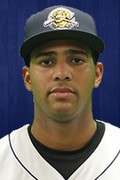 No. 19: DERMIS GARCIA, 3b
No. 19: DERMIS GARCIA, 3b
DOB: January 7th, 1998 (age 20)
Height, Weight, Bats/Throws: 6-foot-3, 200 lbs., right/right
Acquired: Signed July 2014 out of the Dominican Republic ($3.2M bonus)
2017 Stats: .249/.357/.542 (144 wRC+), 17 HR, 14.3 BB%, 30.5 K% (266 PA at Rk/A-)
Projected 2018 Level: Low-A and maybe High-A
The Good: The power. That is Garcia’s calling card. He has true 80 power on the 20-80 scouting scale — he hit 30 homers in 143 minor league games before turning 20, which is insane — and it plays as 80 power in games. He’s not just a batting practice hero. Dermis is also a better pure hitter than the stat line would lead you to believe. He knows the strike zone, and when he deems a pitch hittable, he takes a big aggressive hack. Once he learns he can still hit the ball out of the park while taking a more controlled swing, he’ll be a monster.
The Bad: Garcia has a lot of swing-and-miss in his game right now, especially on breaking balls, and it’s unclear how realistic it is for him to close off those holes. He’s not expected to hit for average, and he’s not much of a runner at all, so his offensive value is tied up his power and walks. In fact, his entire value is tied up in his power and walks. Dermis is rough defender at third base and a move to first feels inevitable. For all intents and purposes, Garcia is a one-tool prospect. But if you’re going to be a one-tool prospect, 80 power is a good tool to have.
The Immediate Future: Late last year Garcia finally made his full season debut, and it stands to reason he will return to Low-A Charleston to begin 2018. A midseason promotion to High-A Tampa is possible. Joseph P. Riley Jr. Park in Charleston is only 305 feet to left field and 356 feet to the left-center field gap, so expect Dermis to put up some big power numbers with the RiverDogs. He’s going to be Rule 5 Draft eligible after the season, though unless he has a monster breakout season, he’s still so unrefined at the plate that it figures to be safe to leave him off the 40-man roster another year.
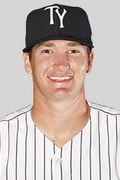 No. 18: KYLE HOLDER, ss
No. 18: KYLE HOLDER, ss
DOB: May 25th, 1994 (age 23)
Height, Weight, Bats/Throws: 6-foot-1, 185 lbs., left/right
Acquired: 2015 supplemental 1st round, 30th overall ($1.8M bonus) (compensation pick for David Robertson)
2017 Stats: .271/.317/.350 (95 wRC+), 4 HR, 5.9 BB%, 14.0 K% (442 PA at A+)
Projected 2018 Level: Double-A and possibly Triple-A
The Good: As the offensive numbers suggest, Holder does his best work in the field, where he is a standout gloveman who could handle shortstop at the MLB level right now. He has great range, baby soft hands, and a strong and accurate arm. The Yankees have had Holder play some second base because they have all their shortstop prospects play second base, but his talents are wasted on the second base side of the bag. Holder’s ceiling isn’t high, but his defense gives him a great chance to carve out a long-term big league role as at least a utility guy.
The Bad: Everything but the defense, basically. Holder isn’t a total zero at the plate — he does make plenty of contact from the left side and will work the count more than his walk rate indicates — but he has zero power and isn’t much of a weapon on the bases either. He’s a pure slap hitter who can play the small ball game (bunt, move runners over, etc.) and bat at the bottom of the lineup. There’s not much offensive upside here at all.
The Immediate Future: This is a big year for Holder, who has performed much better in the second half than the first half in each his two full pro seasons. (He hit .355/.400/.458 in his final 51 games last year.) He’ll be Rule 5 Draft eligible next winter, so this summer at Double-A will determine whether he’s worth a 40-man roster spot. The Yankees sent Holder to the Arizona Fall League last year. They want as much information as possible before making that decision.
 No. 17: JONATHAN LOAISIGA, rhsp
No. 17: JONATHAN LOAISIGA, rhsp
DOB: November 2nd, 1994 (age 23)
Height, Weight, Bats/Throws: 5-foot-11, 165 lbs., right/right
Acquired: Signed February 2016 as a minor league free agent
2017 Stats: 1.38 ERA (2.17 FIP), 27.5 K%, 2.5 BB% (32 IP at Rk/SS)
Projected 2018 Level: Low-A and High-A
The Good: The Yankees signed Loaisiga out of a tryout camp two years ago after he’d been released by the Giants, and soon thereafter he needed Tommy John surgery. Since returning, Loaisiga has consistently shown premium stuff, sitting 91-97 mph with a fastball that has two-seam run back in on righties. A hard low-80s curveball and a quality changeup round out his repertoire. Loaisiga is a very good athlete who repeats his delivery and has no trouble throwing strikes with either the fastball or curveball. Going from minor league washout to Tommy John surgery to 40-man roster player — the Yankees added Loaisiga to the 40-man back in November — in two years is a hell of a ride.
The Bad: In addition to the Tommy John surgery, Loaisiga has a history of arm injuries that led to his release from the Giants. Between the injury history and his slight build — MiLB.com’s height and weight listings are notoriously inaccurate, but in Loaisiga’s case, 5-foot-11 and 165 lbs. is about right — there are concerns he’ll always have trouble staying on the field. The stuff and command are very impressive, especially considering his general lack of experience. Health is a skill though, and Loaisiga has not demonstrated it so far. I can’t help but get a Christian Garcia vibe from him.
The Immediate Future: Now that Loaisiga is on the 40-man roster, the clock is ticking. Three years until he has to stick on the big league roster for good, otherwise be exposed to waivers. For most 23-year-olds, that wouldn’t be a problem. Loaisiga has only thrown 103.2 innings in parts of five minor league seasons though, including only 2.1 innings above the short season leagues. I get the sense the Yankees will try to push him through Low-A and High-A this year so he can split 2019 and 2020 between Double-A Trenton and Triple-A Scranton before burning up his option years. The goal this season is, clearly, stay healthy and rack up innings. (Photo via @MiLB)
 No. 16: NICK SOLAK, 2b
No. 16: NICK SOLAK, 2b
DOB: January 11th, 1995 (age 23)
Height, Weight, Bats/Throws: 5-foot-11, 175 lbs., right/right
Acquired: 2016 second round, 62nd overall ($950,000 bonus)
2017 Stats: .297/.384/.452 (143 wRC+), 12 HR, 11.7 BB%, 18.6 K% (538 PA at A+/AA)
Projected 2018 Level: Double-A and Triple-A
The Good: Given his size and his game, Solak will be (or has been) dubbed gritty and a gamer, and in no way is that inaccurate. He grinds out at-bats, rarely expanding the zone to chase a pitcher’s pitch, and he has the strength to hammer a mistake out of the park. Generally speaking though, Solak is a line-to-line hitter who is at his best when he drives the ball to right field. In addition to the bat, he runs well and won’t clog the bases. Solak split his time between the outfield and second base in college, but he’s played second base exclusively as a pro, where he is a solid defender. The comparisons to Rob Refsnyder are inevitable, though Solak has more pop and a better chance to stick at second base.
The Bad: Solak is one of those prospects with no glaring weakness but also no obvious strength. He does everything well but nothing great. Solak won’t put up big power numbers and won’t steal a ton of bases, so his offensive value is tied to his average and walks. His defense, while not Refsnyderian, is still rough around the edges, and it’s unlikely he’ll ever be above-average at second at the next level.
The Immediate Future: After a month long cameo with Double-A Trenton last season, Solak figures to return to the level this season before getting a midseason bump up to Triple-A Scranton. Given all the middle infield prospects ahead of him on the depth chart, I can’t help but think Solak is trade bait.
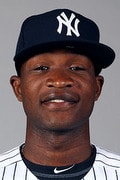 No. 15: DOMINGO GERMAN, rhsp
No. 15: DOMINGO GERMAN, rhsp
DOB: August 4th, 1992 (age 25)
Height, Weight, Bats/Throws: 6-foot-2, 175 lbs., right/right
Acquired: Nathan Eovaldi trade with Marlins (December 19th, 2014)
2017 Stats: 2.91 ERA (2.99 FIP), 26.6 K%, 8.0 BB% (123.2 IP at AA/AAA/MLB)
Projected 2018 Level: Triple-A and MLB
The Good: The long climb up the minor league ladder, which included Tommy John surgery and subsequent rehab, finally paid off for German in 2017. He made his MLB debut and showed off an impressive power arsenal. His sinker averaged 96.5 mph and topped out at 99.1 mph out of the bullpen with the Yankees, though he works more in the 93-95 mph range as a starter. German’s best secondary pitch is a hard upper-80s changeup with good fading action away from lefties. His breaking ball is a slurve that will sometimes look like a slider and sometimes look like a curveball. German threw more strikes last season, his first full season with his new elbow, than at any other point in his career.
The Bad: The inconsistent breaking ball and lack of durability — it’s not just the elbow reconstruction, German has only had two fully healthy seasons since turning pro in 2010 — may lead to a future in the bullpen, which is not necessarily a bad thing. It just means German’s chances of being a cheap rotation piece aren’t great. Also, he’s going to turn 26 this summer, so age is not really on his side. German is getting to the point where it is easy to become an afterthought if you haven’t already established yourself in the big leagues.
The Immediate Future: German will get a long look during Spring Training and, even if he doesn’t win an Opening Day roster spot, he can position himself to be the first guy called up whenever the Yankees need a pitcher, either starter or reliever.
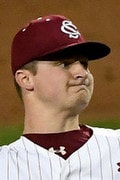 No. 14: CLARKE SCHMIDT, rhsp
No. 14: CLARKE SCHMIDT, rhsp
DOB: February 20th, 1996 (age 21)
Height, Weight, Bats/Throws: 6-foot-1, 205 lbs., right/right
Acquired: 2017 first round, 16th overall ($2.1843M bonus)
2017 Stats: Injured
Projected 2018 Level: Rehab and rookie ball
The Good: The Yankees selected Schmidt with their first round pick last summer even though he had Tommy John surgery a few weeks before the draft. When healthy earlier in the spring, Schmidt was sitting low-90s and touching 96 mph with his fastball, and pairing it with a knockout mid-80s slider that was allergic to bats in college. He can vary the shape of his slider. Sometimes it sweeps across the plate and sometimes it dives down and out of the zone. Schmidt also showed feel for a changeup that gave him a second put-away pitch on his best days. He’s an intense competitor with a bulldog mentality.
The Bad: Well, the whole Tommy John surgery thing stinks. Schmidt had his surgery in late-April and is unlikely to pitch in meaningful games until the middle of this season. Blowing out his elbow did nothing to lessen the concerns about his durability given his size. Also, Schmidt’s delivery can be a little stiff and his command had a tendency to come and go before the injury. The bigger concern is the elbow reconstruction. Even though teams are no longer scared off by Tommy John surgery, it is still a serious injury, and we’re not going to know how Schmidt and his stuff bounce back until he actually gets back on a mound.
The Immediate Future: By all accounts Schmidt’s rehab is going well and he is right on schedule. That rehab schedule is closer to 14-16 months these days, not 12 months like back in the day. That puts Schmidt on target to return to official game action in June or July. It stands to reason the Yankees will treat this coming season as a rehab year. Have Schmidt shake off the rust and get back in the swing of things with one of the short season affiliates, then turn him loose in 2019. (Photo via University of South Carolina)
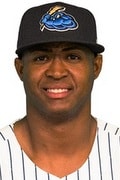 No. 13: DOMINGO ACEVEDO, rhsp
No. 13: DOMINGO ACEVEDO, rhsp
DOB: March 6th, 1994 (age 23)
Height, Weight, Bats/Throws: 6-foot-7, 250 lbs., right/right
Acquired: Signed November 2012 out of the Dominican Republic ($7,500 bonus)
2017 Stats: 3.25 ERA (3.25 FIP), 26.0 K%, 6.2 BB% (133 IP at A+/AA/AAA)
Projected 2018 Level: Double-A, Triple-A, and possibly MLB
The Good: Acevedo is a divisive prospect. His fans see a potential frontline starter thanks in part to unusually strong control for a pitcher this size. His detractors see a future reliever because he lacks a consistent breaking ball and command. But even then, Acevedo has a chance to be an impact reliever because he sits 94-97 mph even as a starter, and has registered 103 mph heaters in the past. His changeup is a legitimately above-average pitch with good arm action and sink. Acevedo’s slider has been a work in progress for years. He’ll snap off a few great ones per start, so you know it’s in there, but he has no consistency with the pitch at all. The stuff can be overwhelming.
The Bad: The lack of a reliable breaking ball is an obvious problem, but I think the lack of command is Acevedo’s biggest issue. He can throw the ball over the plate. Throwing strikes isn’t a problem. Acevedo does a poor job locating to the corners and down in the zone, however, leading to too many hittable pitches out over the plate. If you watched the 2017 Futures Game, you saw what can happen when Acevedo just lays it in there. He has too many games where he relies on raw stuff to succeed rather than stuff plus location. The lack of command stems from a herky jerky delivery Acevedo doesn’t repeat at all. Also, he has an injury history, albeit one without any surgeries. This is a classic high risk, high reward pitching prospect. Acevedo has to figure out a breaking ball and get his mechanics under control to have a chance to start long-term.
The Immediate Future: The Yankees added Acevedo to the 40-man roster back in November, which makes him a potential call-up candidate this summer. I expect him to start the season back with Double-A Trenton — he made only 14 starts there last year (and two more spot starts with Triple-A Scranton) — before a midseason bump up to Triple-A. My guess is the Yankees would prefer to keep Acevedo down pretty much all year so he can work on his delivery and slider.
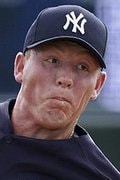 No. 12: MATT SAUER, rhsp
No. 12: MATT SAUER, rhsp
DOB: January 21st, 1999 (age 19)
Height, Weight, Bats/Throws: 6-foot-4, 195 lbs., right/right
Acquired: 2017 second round, 54th overall ($2.4975M bonus)
2017 Stats: 5.40 ERA (3.68 FIP), 21.1 K%, 14.0 BB% (11.2 IP at Rk)
Projected 2018 Level: Extended Spring Training and rookie ball
The Good: The Yankees signed Schmidt to a below-slot bonus as their first rounder last summer and gave the savings to Sauer, who was a borderline first round talent going into the draft. He’s an arm strength prospect with a chance for four pitches when it’s all said and done. His fastball sits 92-95 mph and has touched 97 mph, and has run back in on righties. A low-to-mid-80s slider is Sauer’s go-to secondary pitch, but he’s also shown the ability to spin a curveball and get fade on a changeup. Sauer is a good athlete and a hard worker with a very high compete level. The raw tools are impressive.
The Bad: Aside from the usual stuff associated with his school pitchers — his third (and fourth) pitch lag, he doesn’t know how to hold runners, etc. — the biggest knock on Sauer is his delivery. It’s stiff and he has a long arm action, which hurts his control. Throwing strikes can be a problem. More than a few scouting reports have pegged him as a future reliever if he doesn’t make mechanical tweaks. The stuff is good, but if Sauer can’t repeat his delivery and throw strikes, the stuff won’t matter.
The Immediate Future: The Yankees are going to continue to use Sauer as a starter, because duh. He’s so young and so talented. No need to move him to the bullpen yet. Given his experience level and developmental needs, starting the season in Extended Spring Training before joining one of the short season teams in June strikes me as the likely plan in 2018. (Photo via @MLBPipeline)
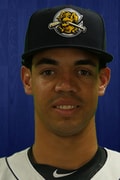 No. 11: FREICER PEREZ, rhsp
No. 11: FREICER PEREZ, rhsp
DOB: March 14, 1996 (age 21)
Height, Weight, Bats/Throws: 6-foot-8, 190 lbs., right/right
Acquired: Signed December 2014 out of the Dominican Republic ($10,000 bonus)
2017 Stats: 2.84 ERA (3.59 FIP), 22.7 K%, 8.7 BB% (123.2 IP at A-)
Projected 2018 Level: High-A and possibly Double-A
The Good: The 2014-15 international spending spree hasn’t paid off as hoped, but in Perez, the Yankees landed a quality pitching prospect on the cheap. Perez had an uncoordinated delivery and an upper-80s/low-90s fastball when he signed, but nowadays he does a better job repeating his delivery and will sit 94-97 mph with his heater, touching 100 mph. His curveball is a hammer, a true swing-and-miss pitch on his best days, and Perez also shows a quality changeup and slider on some days. There’s a chance for two great pitches (fastball, curveball) and two other good pitches (slider, changeup) here. Given his size and stuff, Perez has the potential to be an impact big leaguer.
The Bad: Even with all the progress he’s made since signing, Perez is still working to gain consistency with his delivery, and refine his mechanics. He’s long and lanky, and sometimes his delivery will fall out of whack in the middle of a start. Throwing strikes can be an issue at times for that reason. He’s still working to be consistent with the curveball so it is that hammer pitch every time he throws it, and both the slider and changeup remain works in progress. Perez signed at 18, so he was older than the typical international free agent, but being older than the typical international free agent doesn’t make him more experienced. He’s still got a lot to work on.
The Immediate Future: Perez spent the entire 2017 season at Low-A Charleston, so a move up to High-A Tampa is the obvious move this year. Also, he’s going to be Rule 5 Draft eligible after this coming season, so don’t be surprised if the Yankees bump Perez up to Double-A at some point, just to see him against more advanced hitters before putting him on the 40-man roster. Either way, I think he’s a lock for a 40-man spot come November.
 No. 10: THAIRO ESTRADA, ss
No. 10: THAIRO ESTRADA, ss
DOB: February 22nd, 1996 (age 21)
Height, Weight, Bats/Throws: 5-foot-10, 185 lbs., right/right
Acquired: Signed July 2012 out of Venezuela ($49,000 bonus)
2017 Stats: .301/.353/.392 (107 wRC+), 6 HR, 6.3 BB%, 10.3 K% (542 PA at AA)
Projected 2018 Level: Triple-A and likely MLB
The Good: Thairo made the jump from interesting Single-A prospect to bonafide upper level prospect on the cusp of the big leagues last season. He’s not a big guy and power isn’t his game, but he’s a bat control freak who can put the ball in play and spray it all around the field. It’s a very similar offensive profile to Ronald Torreyes, except Estrada makes harder contact, will take a walk, and has more speed. In the field, Estrada has all the tools necessary to be an above-average defensive shortstop (good hands, good range, good arm) and has shown the aptitude to move around the diamond without missing a beat. He’s played second and third bases and looked natural there.
The Bad: There are two glaring weaknesses in Estrada’s game. One, he doesn’t have much power. And two, he is a sneaky bad baserunner despite his speed. He is 26-for-45 (58%) stealing bases the last two seasons and is known to pull the occasional TOOTBLAN. There’s not much Thairo can do about his lack of power. At some point you either have the strength to hit the ball out of the park or you don’t. With any luck, the baserunning will improve with experience. Estrada has legitimate two-way value, but the lack of extra-base thump limits his ceiling.
The Immediate Future: The Yankees added Estrada to the 40-man roster earlier this offseason and he will be in the infield mix in Spring Training. Would the Yankees actually jump him over Triple-A entirely and carry him on the Opening Day roster? I doubt it, but stranger things have happened. Given all the higher ceiling infielders ahead of Estrada on the depth chart, it’s difficult to see how he fits with the Yankees long-term aside from being a bench player or trade chip.
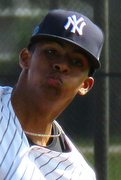 No. 9: LUIS MEDINA, rhsp
No. 9: LUIS MEDINA, rhsp
DOB: May 3rd, 1999 (age 18)
Height, Weight, Bats/Throws: 6-foot-1, 175 lbs., right/right
Acquired: Signed July 2015 out of the Dominican Republic ($280,000 bonus)
2017 Stats: 5.09 ERA (4.64 FIP), 22.2 K%, 14.1 BB% (23 IP at Rk)
Projected 2018 Level: Extended Spring Training and rookie ball
The Good: No pitcher in the farm system has more upside than Medina. He’ll sit 95-98 mph like it’s a walk in the park, and he’s hit 102 mph many times since signing. Medina can also spin a high quality low-80s power curveball, and he also shows surprisingly good feel for a changeup. He has top 1% stuff for a teenager. Medina has long limbs and a lanky frame, so he still has room to fill out and possibly add even more velocity.
The Bad: Pretty much everything else. Medina is very raw. His delivery has improved, but he still struggles to repeat it, and he has a hard time throwing strikes. The curveball and changeup are inconsistent, though that isn’t terribly surprising given his age. Medina is still ironing out his delivery and learning how to harness his electric stuff. His ceiling is sky high, but he has a long way to go to get from here to there.
The Immediate Future: Given his age and general crudeness, the smart money is on Medina starting the season in Extended Spring Training before joining one of the short season leagues in June. A return trip to Pulaski seems likely. Maybe Staten Island if he makes enough improvement in Extended Spring Training. (Photo via Pinstriped Prospects)
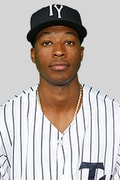 No. 8: DILLON TATE, rhsp
No. 8: DILLON TATE, rhsp
DOB: May 1st, 1994 (age 23)
Height, Weight, Bats/Throws: 6-foot-2, 195 lbs., right/right
Acquired: Carlos Beltran trade with Rangers (August 1st, 2016)
2017 Stats: 2.81 ERA (3.95 FIP), 18.4 K%, 7.0 BB% (83.1 IP at A+/AA)
Projected 2018 Level: Double-A and Triple-A
The Good: Tate is back to where he was a few years ago, when the Rangers made him the fourth overall pick (and first pitcher taken) in the 2015 draft. He’s gone back to his college delivery — Texas tried to simplify things back in 2016 and that fouled him up — which means an exaggerated leg kick and some head violence. With that delivery comes a 92-97 mph fastball that will touch 99 mph, as well as a quality slider and changeup. Throwing strikes isn’t much of a problem, though Tate is definitely more control than command right now. He’s a stuff first, location second pitching prospect.
The Bad: There is an Eovaldian quality to Tate’s staff, meaning his fastball is more hittable than the velocity would lead you to believe, and neither the slider nor the changeup are consistent out pitches. On his best days he’ll be untouchable. On an average day, he’ll leave you wanting more. Also, Tate missed the start of last season with a shoulder problem. He finished the season healthy and was throwing gas in the Double-A postseason, but still. A shoulder issue is never good.
The Immediate Future: There is definitely a chance Tate’s long-term future lies in the bullpen, where he could be a high-leverage arm. For now the Yankees will keep Tate in the rotation and try to groom him as a starter, which is what they do with all their best pitching prospects. He could make his MLB debut this summer — Tate has to be added to the 40-man roster after the season — though I don’t think the Yankees are going to force anything.
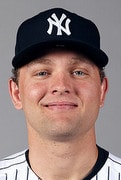 No. 7: CHANCE ADAMS, rhsp
No. 7: CHANCE ADAMS, rhsp
DOB: August 10th, 1994 (age 23)
Height, Weight, Bats/Throws: 6-foot-0, 210 lbs., right/right
Acquired: 2015 fifth round, 153rd overall ($330,000 bonus)
2017 Stats: 2.45 ERA (3.70 FIP), 22.3 K%, 9.6 BB% (150.1 IP at AA/AAA)
Projected 2018 Level: Triple-A and MLB
The Good: The reliever-to-starter conversion is going as well as anyone could’ve reasonably hoped. Adams’ second season as a rotation member was not quite as good as the first statistically, but, more importantly, he handled the workload well and maintained his stuff. Adams will work in the 93-95 mph range and hold that velocity deep into starts. He has two quality breaking balls in his mid-80s slider and upper-70s curveball, though he tends to lean on the slider when he needs to get out of a jam. Adams also has a changeup, which is a clear fourth pitch for him. Four workable (or better) pitchers and a strong, sturdy frame is a great building block for a pitching prospect.
The Bad: It’s a longer list than you’d like. Adams’ fastball is true and he doesn’t get great downhill plane on the pitch, resulting in a lot of fly balls. A 41.4% ground ball rate against Triple-A hitters is kinda scary. Also, Adams did not make much progress with his changeup last season, and he took a step back with his control. He had a tendency to nibble. That’s why his strikeout and walk rates went from 29.1% and 7.9% in 2016, respectively, to 22.3% and 9.6% in 2017. Individually, you can live with fly balls and you can live with walks. Combine the two and you’re in trouble, especially in Yankee Stadium.
The Immediate Future: The Yankees did not call Adams up last season when they needed a reliever at midseason or a starter in the second half, which tells us they do not consider him a finished product. And that’s perfectly fine. Adams has only been a starter for two seasons and he doesn’t have to be added to the 40-man roster until next winter. This year Adams could be the sixth starter right from Opening Day. He’s very likely to make his big league at some point this summer.
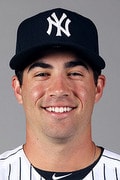 No. 6: TYLER WADE, ss
No. 6: TYLER WADE, ss
DOB: November 23rd, 1994 (age 23)
Height, Weight, Bats/Throws: 6-foot-1, 185 lbs., left/right
Acquired: 2013 fourth round, 134th overall ($371,300 bonus)
2017 Stats: .280/.361/.426 (120 wRC+), 7 HR, 9.6 BB%, 20.9 K% (449 PA at AAA/MLB)
Projected 2018 Level: Triple-A and MLB
The Good: Aside from hit for power, Wade can do pretty much everything at an average or better rate. He’s a slash-and-dash left-handed hitter who knows the strike zone and runs very well, so given his lack of power, it’s pretty much the classic leadoff hitter profile. Wade is a natural shortstop and a very good defender, with good range and great hands, and an adequate arm for the left side of the infield. The Yankees have taken advantage of his athleticism and moved him all around the field in an effort to increase his versatility. Wade has played plenty of second base in addition to short, and has also spent time at third base and in the three outfield positions.
The Bad: Wade was completely overmatched during his brief big league stint last season, which only heightened concerns about his ability to handle MLB caliber pitching. High-end velocity can give him problems and, when behind in the count, his protect mode doesn’t lead to much solid contact. Also, on defense, Wade’s arm is just okay. It’s basically the bare minimum for shortstop and third base. He has the hands and feet for the left side of the infield. The arm is a little less than you’d like at those positions though.
The Immediate Future: Wade exhausted his rookie eligibility last season based on service time, but he didn’t exceed the 130 at-bat limit (he had 58), which is why I consider him prospect eligible. Anyway, Wade will be in the mix for the second and third base jobs in Spring Training, and given his versatility, he could wind up on the bench even if he doesn’t win a starting job.
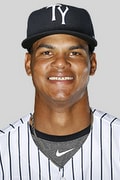 No. 5: ALBERT ABREU, rhsp
No. 5: ALBERT ABREU, rhsp
DOB: September 26th, 1995 (age 22)
Height, Weight, Bats/Throws: 6-foot-2, 175 lbs., right/right
Acquired: Brian McCann trade with Astros (November 17th, 2016)
2017 Stats: 3.37 ERA (3.12 FIP), 27.6 K%, 8.1 BB% (53.1 IP at Rk/A-/A+)
Projected 2018 Level: High-A and Double-A
The Good: It’s not often a player can miss close to three months with two different injuries and raise his prospect stock, but Abreu did exactly that last season. His stuff is electric, rivaling Medina’s for the best in the system, and he made real improvements with his command. Abreu sits 93-98 mph and looks like he’s playing catch — the ball comes out of his hand so effortlessly — and he’s run it up as high as 100 mph. He did a much better job locating that heater last year. At this point his slider is his best and most reliable secondary pitch, though Abreu also uses a curveball and changeup regularly. All three non-fastballs are capable of missing bats. The ceiling here is considerable.
The Bad: Abreu did miss close to three months with injuries last season — first with an elbow issue, then with a lat issue — though he finished healthy and impressed in the Arizona Fall League. Still, injuries are injuries. On the mound, Abreu needs to continue gaining consistency with his secondary pitches and improve his overall command more than anything, which makes him like countless other pitching prospects in the minors.
The Immediate Future: Because he missed all that time last year, I expect Abreu to go back to High-A Tampa this season, at least until the weather warms up. Then he’ll go to Double-A Trenton. Appendix surgery will slow his progress a bit. Abreu was added to the 40-man roster this offseason, but I’d be surprised if he makes his big league debut this year, even as a September call-up.
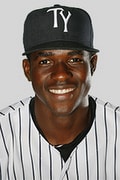 No. 4: ESTEVAN FLORIAL, of
No. 4: ESTEVAN FLORIAL, of
DOB: November 25th, 1997 (age 20)
Height, Weight, Bats/Throws: 6-foot-1, 185 lbs., left/right
Acquired: Signed March 2015 out of the Dominican Republic ($200,000 bonus)
2017 Stats: .298/.372/.479 (145 wRC+), 13 HR, 31.1 K%, 10.5 BB% (476 PA at A-/A+)
Projected 2018 Level: High-A and Double-A
The Good: No player in the system is more tooled up than Florial. He’s a physical specimen and a high-end athlete with big raw power, a top of the line arm, and well-above-average speed. Florial puts on a show in batting practice and is capable of driving the ball out of the park to all fields. He can also beat you on the bases and take away runs in the field. I wouldn’t call Florial a true five-tool player because there are long-term questions about his ability to hit for average, but the four other tools are as good as it gets. There is legitimate impact player potential here. Florial could be a star.
The Bad: The only negative in Florial’s game — and it’s a big one — is his inability to make consistent contact and stay in control at the plate. He’ll murder a fastball, but Double-A caliber pitchers in the Arizona Fall League gave him fits with breaking balls. The Yankees love Florial’s makeup and work ethic, and because he didn’t play baseball much growing up in Haiti, they expect his contact rate and plate discipline to improve with experience. For now, those contact issues are a legitimate question. He’ll have to overcome them to have success at the next level.
The Immediate Future: The Yankees gave Florial a taste of Double-A in the postseason last year, though he only played 19 games with High-A Tampa, so he’ll likely head back there to begin this season. A midseason promotion back up to Double-A seems likely. Florial will be Rule 5 Draft eligible next offseason, though there’s no doubt the Yankees will add him to the 40-man roster.
 No. 3: MIGUEL ANDUJAR, 3b
No. 3: MIGUEL ANDUJAR, 3b
DOB: March 2nd, 1995 (age 22)
Height, Weight, Bats/Throws: 6-foot-0, 215 lbs., right/right
Acquired: Signed July 2011 out of the Dominican Republic ($750,000 bonus)
2017 Stats: .318/.364/.503 (135 wRC+), 16 HR, 5.7 BB%, 13.4 K% (530 PA at AA/AAA/MLB)
Projected 2018 Level: Triple-A and MLB
The Good: It has been a steady climb up the minor league ladder for Andujar. He’s broken out the last two seasons thanks to a unique contact/power combination. Andujar is an aggressive hitter who expands the zone regularly, but he makes consistent quality contact, limiting his swings and misses and strikeouts. He’s a hacker, but it’s more of a low walks/low strikeouts profile than a low walks/high strikeouts profile. Andujar does the most damage when he pulls the ball to left field, though he will go the other way on occasion. His best tool defensively is a rocket arm that is more than enough for third.
The Bad: Andujar doesn’t figure to ever be a high on-base player and it is entirely possible the whole “swing at everything” approach won’t work against big league caliber pitching. There is definitely the potential for a lot of Starlin Castro-esque “he got himself out” at-bats. Right now, the biggest knock on Andujar’s game comes in the field. He has some bad habits to correct — Andujar will rush to make plays and he tends to make off-line throws when he drops down and slings the ball sidearm — and the Yankees have been working with him to improve that. Andujar was on the field with former third base/infield coach Joe Espada every afternoon last September, taking ground ball after ground ball after ground ball.
The Immediate Future: The Chase Headley trade opened up third base and Andujar will go to camp with a chance to win the job this spring. In fact, given the current in-house options, I think Andujar is the favorite to start at third base on Opening Day. We’ll see. If he doesn’t win the job in camp, he’ll go to Triple-A Scranton and await the inevitable call-up.
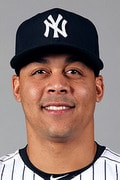 No. 2: JUSTUS SHEFFIELD, lhsp
No. 2: JUSTUS SHEFFIELD, lhsp
DOB: May 13th, 1996 (age 21)
Height, Weight, Bats/Throws: 5-foot-11, 200 lbs., left/left
Acquired: Andrew Miller trade with Indians (July 31st, 2016)
2017 Stats: 3.12 ERA (4.43 FIP), 20.8 K%, 8.0 BB% (98 IP at Rk/AA)
Projected 2018 Level: Double-A and Triple-A, possibly MLB
The Good: Even at his size, Sheffield has big time stuff from the left side. He spent last summer operating at 92-95 mph and topping out at 97 mph, and his fastball has natural two-seam run back in on left-handed hitters. Sheffield’s slider is devastating on its best days and merely very good on most days. It’s sharp and sweepy in the mid-80s, and both lefties and righties consistently swing over the pitch. Sheffield’s changeup is coming along well and he can miss bats with it, though it is his third pitch at this point. His arm is healthy, he’s athletic and he repeats his delivery well, he’s a hard worker, and he’s not far away from having three truly above-average pitches. Lots to like here.
The Bad: Despite his athleticism and consistent delivery, Sheffield’s control can come and go at times, leading to walks and high pitch counts. That’s not terribly uncommon for a pitcher his age, though it is something that needs to be improved. Also, Sheffield is on the short side, which creates concerns about his ability to get downhill plane and keep the ball on the ground. (He allowed 14 homers in 19 starts last season, which is an awful lot for a top pitching prospect.) There’s also the oblique injury that sidelined Sheffield for most of the second half last year. The good news is his arm is fine. The bad news is that he lost about two months of development time.
The Immediate Future: If not for the oblique injury, I’d say Sheffield is ticketed for Triple-A Scranton to begin the season. But after missing all that time, I think he’ll return to Double-A Trenton for at least a few weeks before going up to Scranton. There’s an outside chance Sheffield, who has to be added to the 40-man roster after the season, will make his MLB debut in the second half.
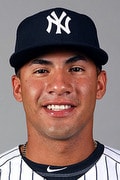 No. 1: GLEYBER TORRES, ss
No. 1: GLEYBER TORRES, ss
DOB: December 13th, 1996 (age 21)
Height, Weight, Bats/Throws: 6-foot-1, 175 lbs., right/right
Acquired: Aroldis Chapman trade with Cubs (July 25th, 2016)
2017 Stats: .287/.383/.480 (141 wRC+), 7 HR, 12.8 BB%, 20.0 K% (235 PA at AA/AAA)
Projected 2018 Level: Triple-A and MLB
The Good: Torres is not just the Yankees’ top prospect, he’s on the very short list of the best prospects in baseball. He’s an aggressive swinger but also under control, with good pitch recognition and the ability to made adjustments in the middle of at-bats. Gleyber will take his walks and spray the ball to all fields, including over the fence. In the field, he’s overcome early career questions about his mobility and hands to become an above-average defensive shortstop with smooth actions and a strong arm. The Yankees had Torres spend time at second and third base last season in an effort to increase his versatility, and also fit him into the big league lineup. Second base seems like Gleyber’s long-term home because of Didi Gregorius, not because of his defensive shortcomings. Torres has all the tools necessary to be a star-caliber shortstop.
The Bad: Obviously, missing the second half of last season with Tommy John surgery on his non-throwing elbow is a big deal, though Torres has completed his rehab and will be ready for the start of camp next week. It’s good his rehab is done. That said, it’s still 300-something plate appearances he lost to injury. That’s real development time. There are some questions about his long-term power potential — some see him as a 10-15 homer guy and others see a consistent 20+ homer guy — and, for what it’s worth, Gleyber’s performance has always been a notch or two below what you’d expect from his a guy with his tools. He hasn’t been bad in the minors. Not by any means. But he hasn’t knocked your socks off statistically like some other top prospects in the minors, like Vladimir Guerrero Jr. or Ronald Acuna.
The Immediate Future: Brian Cashman insists Torres will have a chance to win a big league infield spot in Spring Training and I do believe him. Torres is supremely talented and he’s already on the 40-man roster. At the same time, Gleyber is coming off a serious injury, he hasn’t hit in games since June, and he’s played only 55 games above Single-A ball (23 at Triple-A). Some time in the minors to shake off the rust and get back up to speed wouldn’t be unexpected. As an added bonus (for the Yankees), two and a half weeks in the minors would delay his free agency one year. The Yankees usually don’t obsess over service time, but Torres is a bit of a special case. “Buying” that extra year of control is sooo tempting.
* * *
The Yankees have graduated or traded away a lot of quality prospects over the last 18 months or so, enough to build a respectable top ten prospects list. Since I know the questions are coming, here’s where those prospects would slot into this year’s top 30. This list is sexy AF:
- SS Gleyber Torres
- OF Clint Frazier (graduated to MLB by four at-bats)
- LHSP Justus Sheffield
- 3B Miguel Andujar
- SS Jorge Mateo (Sonny Gray trade)
- OF Estevan Florial
- RHSP Jorge Guzman (Giancarlo Stanton trade)
- RHSP Albert Abreu
- OF Blake Rutherford (David Robertson/Tommy Kahnle/Todd Frazier trade)
- SS Tyler Wade
- RHSP Chance Adams
- OF Dustin Fowler (Sonny Gray trade)
- RHSP Dillon Tate
- RHSP James Kaprielian (Sonny Gray trade)
- RHSP Luis Medina
- SS Thairo Estrada
- RHSP Freicer Perez
- RHSP Matt Sauer
- RHSP Domingo Acevedo
- RHSP Clarke Schmidt
- RHSP Domingo German
- 2B Nick Solak
- RHSP Jonathan Loaisiga
- SS Kyle Holder
- 3B Dermis Garcia
- SS Hoy Jun Park
- RHSP Trevor Stephan
- RHSP Zack Littell (Jaime Garcia trade)
- RHSP Taylor Widener
- LHSP Ian Clarkin (David Robertson/Tommy Kahnle/Todd Frazier trade)
Both RHRP Jonathan Holder and 1B Tyler Austin are still prospect eligible but were not serious considerations for this year’s top 30. Holder (2.1 innings) and Austin (seven at-bats) are just short of the rookie thresholds. Others who made midseason editions of the top 30 last year, like C Donny Sands and RHSP Nolan Martinez, were in the mix again this year, but fell short. So it goes. Life is good when prospects like those guys don’t make your organizational top 30.
Leave a Reply
You must be logged in to post a comment.